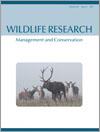Context. Intraspecific differences in behaviour can affect censuses and bias population estimates, suggesting that choice and implementation of census methods are fundamental, and need to be adapted to behavioural variations.
Aims. We investigated temporal variations in activity patterns during the rut among red deer (Cervus elaphus) categories and the implications for two different census methods.
Methods. We used a long-term dataset collected during 17 consecutive red deer rutting seasons in southernmost Sweden. The two census methods were: (1) a collection of observation ratios; and (2) a count of individuals including identification of males. Both methods are commonly used in ungulate management.
Key results. There was a difference in activity among age and sex categories, with a temporal variation in activity and/or presence at rutting grounds of adult (≥6 years) and subadult (2–5 years) males. Observation ratios of adult and subadult males increased from low at the start of the rut to a top level during peak rut, with subadults lagging behind adults. Before and during peak rut, the proportion of adult males was higher than that of subadults. After peak rut, the proportion of adult males decreased, whereas subadult males remained high, resulting in a higher number of subadults than of adults. The comparison of the two census methods revealed a strong correlation regarding the trends of population size and for the age and sex categories. There was also a strong consistency concerning the calf/female ratio. The male proportion was, however, consistently lower in the collected observations than in the counts.
Conclusions. The lower proportion of males in observations compared with counts may be explained by behavioural differences among male age classes, i.e. by temporal variations in presence and activity. That females, calves and yearling males are stationary during the rut, but adult and subadult males arrive and depart the rutting grounds at varying points of time, can lead to an underestimated male proportion in continuously collected observation data.
Implications. The results suggest that census should be conducted during peak rut, and that incorporating identification of individual males in the monitoring may be beneficiary.





